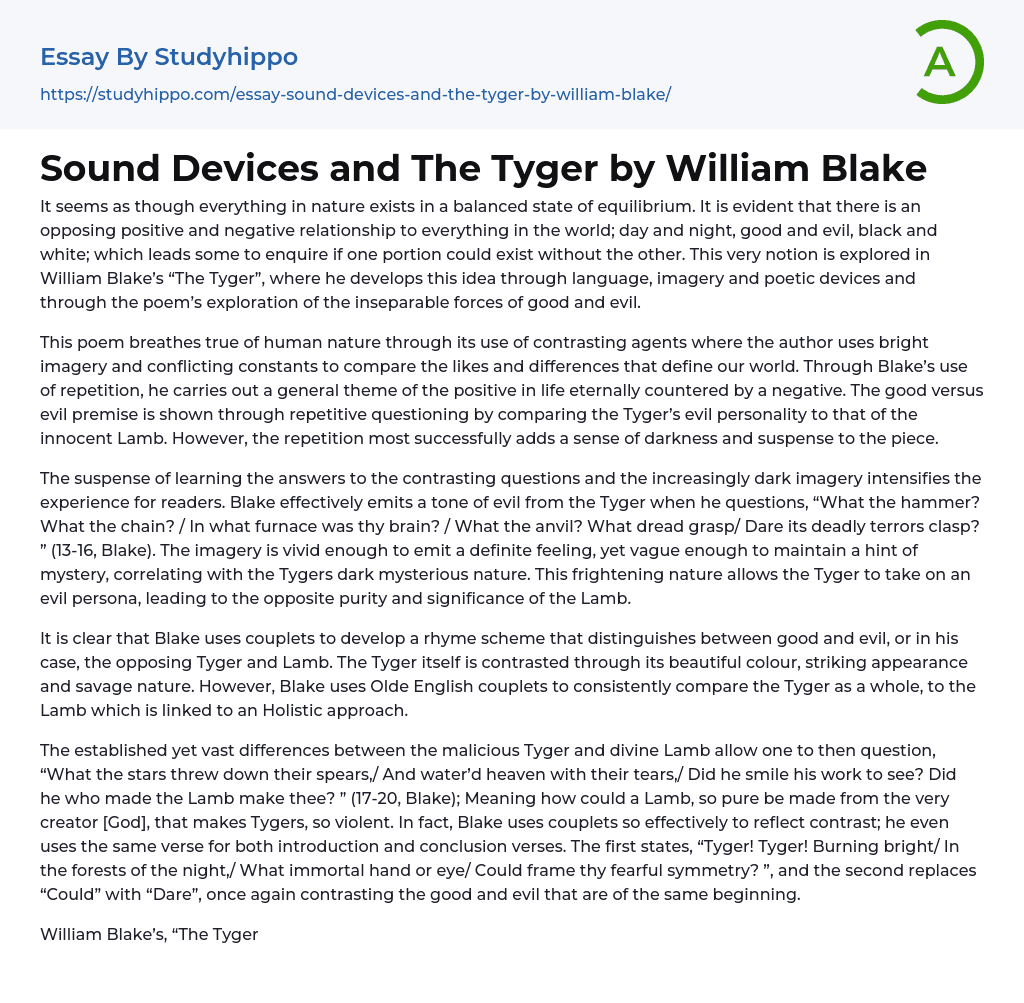

Sound Devices and The Tyger by William Blake Essay Example
It seems as though everything in nature exists in a balanced state of equilibrium. It is evident that there is an opposing positive and negative relationship to everything in the world; day and night, good and evil, black and white; which leads some to enquire if one portion could exist without the other. This very notion is explored in William Blake’s “The Tyger”, where he develops this idea through language, imagery and poetic devices and through the poem’s exploration of the inseparable forces of good and evil.
This poem breathes true of human nature through its use of contrasting agents where the author uses bright imagery and conflicting constants to compare the likes and differences that define our world. Through Blake’s use of repetition, he carries out a general theme of the positive in
...life eternally countered by a negative. The good versus evil premise is shown through repetitive questioning by comparing the Tyger’s evil personality to that of the innocent Lamb. However, the repetition most successfully adds a sense of darkness and suspense to the piece.
The suspense of learning the answers to the contrasting questions and the increasingly dark imagery intensifies the experience for readers. Blake effectively emits a tone of evil from the Tyger when he questions, “What the hammer? What the chain? / In what furnace was thy brain? / What the anvil? What dread grasp/ Dare its deadly terrors clasp? ” (13-16, Blake). The imagery is vivid enough to emit a definite feeling, yet vague enough to maintain a hint of mystery, correlating with the Tygers dark mysterious nature. This frightening nature allows the Tyger to
take on an evil persona, leading to the opposite purity and significance of the Lamb.
It is clear that Blake uses couplets to develop a rhyme scheme that distinguishes between good and evil, or in his case, the opposing Tyger and Lamb. The Tyger itself is contrasted through its beautiful colour, striking appearance and savage nature. However, Blake uses Olde English couplets to consistently compare the Tyger as a whole, to the Lamb which is linked to an Holistic approach.
The established yet vast differences between the malicious Tyger and divine Lamb allow one to then question, “What the stars threw down their spears,/ And water’d heaven with their tears,/ Did he smile his work to see? Did he who made the Lamb make thee? ” (17-20, Blake); Meaning how could a Lamb, so pure be made from the very creator [God], that makes Tygers, so violent. In fact, Blake uses couplets so effectively to reflect contrast; he even uses the same verse for both introduction and conclusion verses. The first states, “Tyger! Tyger! Burning bright/ In the forests of the night,/ What immortal hand or eye/ Could frame thy fearful symmetry? ”, and the second replaces “Could” with “Dare”, once again contrasting the good and evil that are of the same beginning.
William Blake’s, “The Tyger” is a reflection of human nature and illustrates through imagery and sound devices that the perpetual contrasts of good and evil lead us to question ones’ creator. If God being Sheppard of his Lamb/flock is supposedly an abundance of religious stature; then how is its opposite in nature –a cornucopia of immorality, the Tyger, can
be from one of the same? It is this struggle that allows human nature to exist, a constant battle for balance between good and evil; that is, one needs the other in order to survive.
- Book Summary essays
- Metaphor essays
- Reader essays
- Rhyme essays
- Literary devices essays
- Villain essays
- Books essays
- Genre essays
- Literary Criticism essays
- Writer essays
- Protagonist essays
- Simile essays
- Poem essays
- Book Report essays
- Book Review essays
- Greek Mythology essays
- Plot essays
- Tragic Hero essays
- Coming of Age essays
- Play essays
- Rhetoric essays
- Rhetorical Question essays
- Translation essays
- Understanding essays
- Reason essays
- Character essays
- Letter essays
- American Literature essays
- Literature Review essays
- Utopia essays
- Poetry Analysis essays
- Dante's Inferno essays
- Between The World and Me essays
- Incidents in The Life of a Slave Girl essays
- Flowers for Algernon essays
- Myth essays
- Everyday Use essays
- Boo Radley essays
- Genesis essays
- Richard iii essays
- Alice in Wonderland essays
- On the road essays
- Ozymandias essays
- The Nightingale essays
- Holden Caulfield essays
- Animal Farm essays
- 1984 essays
- A Hanging essays
- Shooting An Elephant essays
- A Tale Of Two Cities essays



